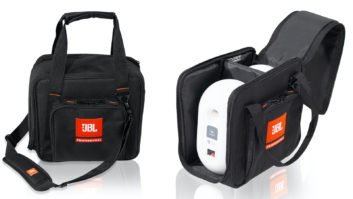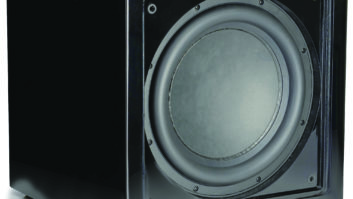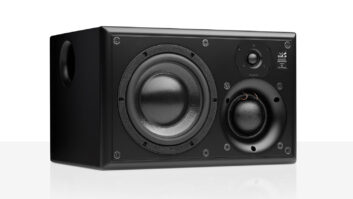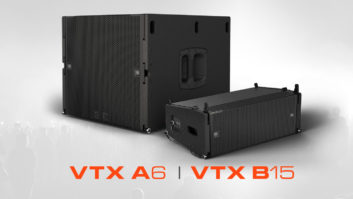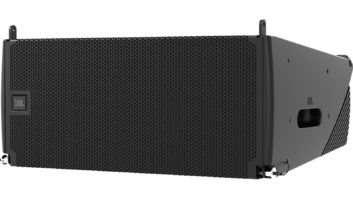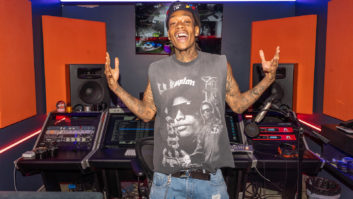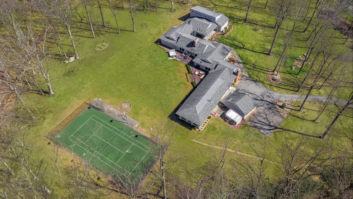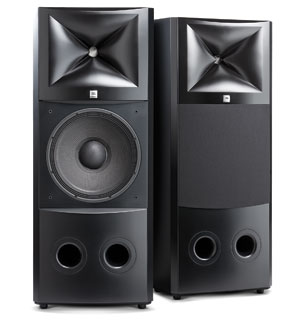
JBL M2
A rich and storied legacy, one associated with integrity, quality, reliability and performance, is obviously a good thing to have for any company in any market. Of course it is. It brings built-in brand recognition, lower barriers of entry to new markets, trusted experience, scale, volume, employee pride and countless other benefits. But having a rich and storied legacy can also be a curse, especially in technology-related industries, where the pace of change has accelerated exponentially in the global market and the pressure from new and varied competitors is constant. Maintaining a legacy in the modern world can be every bit as challenging as building one. The overriding requirements, it seems, are an unceasing drive to innovate and an uncompromised approach to quality.
There are a number of companies in professional audio that meet the criteria; we are an industry built on loyalty, trust and a thirst for vintage gear. But consider JBL: approaching 70 years as a company in its own right, with another 20 years of loudspeaker development and culture tacked on for the founder, James B. Lansing, who began designing horns and drivers to usher in the age of film sound. A company that straddles pro and consumer, across multiple markets, including cinema, studio, installation, touring, hi-fi and automotive. A company that has risen and fallen with business cycles many times over many years. A company that has virtually “owned” entire markets for extended periods of time, then lost ground, then boomed again. There are many great loudspeaker manufacturers in professional audio, many with storied histories, but JBL remains unique.
In late 2012, 65 years after the founding of the company with the famed D130 driver and 75 years after James B. Lansing released the Iconic, the first real studio monitor, JBL showed what they termed a “next-generation studio monitor” in a seminar at AES. It was a quiet introduction, followed up by an official launch of the M2 Master Reference Monitor at NAMM a few months later. But what it signaled was much larger: a re-ignition of the studio line, based once again on innovation. To put it another way, JBL didn’t build a new speaker; they developed new technologies, then integrated them and built a new line of speakers, across multiple markets. The Technologies of M2


The D2 Dual-Diaphragm Dual-Voice-Coil Driver
“From the very founding, with James B. Lansing, the company has been about using high-quality materials to deliver high-quality performance,” says Director of JBL Technology Mark Gander, who joined JBL in 1976 as a transducer engineer so that he could “apprentice with the masters.” “We may integrate the technologies and elements in a unique way, for either studio or live,” he says, “but it is still all about sonic accuracy.
“For example, the D2 compression driver, which we feel is a real step forward with two annular diaphragms, was developed as a high-performance element, just like the D130 was designed as a high-performance element,” he continues. “We happened to put it first in the VTX line array. It could have just as easily started in the M2, but in a studio monitor we still needed a very specific kind of waveguide to give it very even coverage and low distortion. The D2 does the same job and has the same stringent requirements, live and studio, but it’s customized and integrated to fit the application.”
The D2 dual-diaphragm, dual-voice coil compression driver was designed by Senior Manager of Transducer Design Alexander Voishvillo, for VTX, the line array system introduced in January 2012. Voishvillo, a Ph.D. who in a previous life designed studio monitors for the Russian Broadcasting Corporation, came up with the idea of foregoing the more traditional dome compression driver and developing a dual-annular diaphragm with dual 3.5-inch voice coils. The result was higher SPL, greater efficiency, less power required.
“We split into two annular diaphragms made out of special high polymers, thermoformed and very light,” Voishvillo explains. “Then we have two coils doing the job of one coil. That means there is half as much power delivered to each coil, so we have low thermal compression. It’s lighter, more flexible, with lower moving mass, matching phasing plugs and internal damping. And it has ultra-low distortion.”
That low distortion led him across the proverbial hallway in JBL’s Northridge, Calif., facility to Peter Chaikin, Senior Manager, JBL Recording and Broadcast Marketing. Chaikin actually had a version of the two-way large-format monitor in early stages of development at the time, focusing on the high-end personal professional studio and post-production houses. When he was introduced to the D2, the ultimate design began to take shape.
“We wanted to make large-format monitoring a viable option for a wide range of production spaces,” Chaikin says. “We needed high output, extended yet neutral frequency response, a small footprint for a broad range of placements, and it had to be tuneable. Conventional compression drivers act like pistons and high frequencies can break up, leading to distortion. The D2 met seemingly opposing objectives: extended high frequencies, very low distortion and very high output.” The M2 team—and it really was a team approach, with expertise across the company—then began integration of a new 2216Nd Differential Drive woofer, chosen as the ideal complement to the D2. Based on JBL’s Differential Drive dual-voice coil design originally developed in the late 1990s, the new 2216Nd contains five patented technologies, including Low TCR edge-wound wire that allows the woofer to maintain constant impedance regardless of output.

The revolutionary, patent-pending Image Control Waveguide.
The key to integrating the driver and woofer, then, was the third key innovation: the patent-pending Image Control Waveguide, developed by Senior Systems Engineer Charles Sprinkle, working side-by side with Harman Corporate Technology Group’s Alan Devantier, responsible for system tuning and design of the enclosure, including the patented front ports.
“The Bi-Radial horn that we have had for decades was a 90×60 horn, and not the best match for the low frequency device in the M2,” Sprinkle says. “This horn is 120 degrees horizontal and 110 degrees vertical. We knew that if we wanted a good directivity transition between the woofer and the high frequencies, we had to have that amount of pattern, so the waveguide was designed to have a pattern consistent with what the woofer was doing with no discontinuity at the crossover point, which is 800 Hz.
“The second thing we did was use a blending geometry—there are no straight lines, you’ll notice—that has a generally decreasing radius,” he continues, “forming an infinite number of reflections, and the net effect is that it smears the reflections coming back down the horn and negates them.
“The third thing we did is bring these ‘knuckles,’ which is a name that sort of stuck, in from the side so that rather than having this 1.5-inch aperture that we had in the Bi-Radial design, we were able to get the upper pattern control frequency up near 10k, much like it would be with a 25mm dome. You combine that with a high-frequency device that has the internal damping characteristics this driver has, and it sounds like a silk-dome! That nice, sweet, effortless, open sound. In the process, that directivity characteristic in the mid-band went away. Alan was really a champion of doing the right thing with the architecture: driver placement, making the cabinet taller—that opened the door to the work that was done on the waveguide.”
From Chaikin’s point of view, the new waveguide delivers remarkable high-frequency detail, a true soundstage with natural balance at nearly any listening position, and a neutral frequency response both on- and off-axis, allowing for optimum performance in a broad range of environments, large and small, whether soffit-mounted, free-standing or behind a screen. A product for the professional in everyone.
Process and Measurement
While the D2, 2216Nd and Image Control Waveguide provide the core, many other technologies round out the system. I-Tech 5000HD amplifiers from fellow Harman company Crown supply the power and the floating-point DSP for the system crossover and the EQ needed for room tuning.

The 2216Nd Differential Drive Woofer
But these are technologies, and lots of people are developing lots of great technologies. What’s different about JBL is the integration of the technologies under a single roof, with a commitment to process, measurement and quality. In the development of any product, engineers have access to four anechoic chambers, multichannel listening labs, power test rooms (100 hours at max SPL for new product designs), interferometers, 3-D printers and rapid prototyping for the constant iterations in product development. Rather than measure a single on-axis frequency response, engineers measure the entire sphere radiated into the listening space—data gathered at every ten degrees and reflecting 1296 times the information of a single-point response curve.
Dr. Sean Olive has been with the company for 20 years as director of acoustic research. He credits Dr. Sidney Harman, who purchased the company in 1969, with “bringing science to the process of speaker development. He didn’t want to sell speakers based on marketing and sales. He wanted the science to back up the claims, and he hired Dr. Floyd Toole to lead the effort.”
In 1993, Olive, working under Dr. Toole, began setting up a system for subjective evaluation of loudspeakers and the correlation of subjective responses and objective measurements. It’s not an easy task, considering one could argue that all aspects of music production and consumption are subjective, speaker preference most of all. By 2004 he had perfected his double-blind listening setup, making use of a pneumatic speaker shuffler that removes the “nuisance variables” that affect perception of the loudspeaker, such as visibility of the brand logo, the size, shape and industrial design of the speaker and awareness of its price point. His papers on the subject are widely circulated; he maintains an active blog that is worth reading. “What we’ve found in general, across age, culture, genre and experience, whether the subject has ear-training or not, is that most people prefer an accurate, neutral monitor,” he explains. “One that maintains the perception of timbre across the frequency spectrum, in the combined direct and reflected source. In developing the speaker, then, the research can get the engineers 90 percent of the way to their goal, which is an even, accurate, neutral listening experience.”
The end result is a free-standing M2 monitor that is 49.5 inches tall, 20 inches wide, and a mere 14 inches deep, with an in-room frequency response of 20 Hz to 40 kHz and 129 dB maximum SPL.
Gander, in summation, describes it as “very, very linear. You still have to start with transducers, the mechanics and electronics. The future is a transducer and a computer with a human interface—from acoustic energy to a digital input and back out to a speaker. We feel good about the future.”
Tom Kenny is the editor of Mix.

The 3 Series
As we went to press, JBL officially announced the 3 Series, which incorporates the patent-pending Image Control Waveguide from the M2, SlipStream low-frequency port design, Linear Spatial Reference design criteria, and Class D amplification. Models include the LSR305 5-inch powered version, with a response of 43 Hz to 24 kHz and peak SPL of 108 dB, and the LSR 308, with a response of 37 Hz to 24 kHz and peak SPL of 112 dB.
